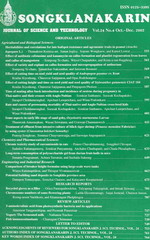ThaiScience
ThaiScience
SONGKLANAKARIN JOURNAL OF SCIENCE & TECHNOLOGY
Volume 42, No. 03, Month MAY, Year 2020, Pages 521 - 532
Water bodies are a critical foraging habitat for insectivorous bats in tropical agricultural landscapes of central thailand
Piyaporn Suksai and Sara Bumrungsri
Abstract Download PDF
Agricultural intensification and homogenization of land use are known to have a negative impact on biodiversity. Bat activity was monitored in five land use types that included paddy fields, field crops, forests, settlements, and water bodies from November 2015 to October 2016 in central Thailand. We recorded 37,610 one-minute intervals with bat calls and 623 feeding buzzes that represented 16 bat species. Bat foraging activity was dominated by open space and edge species. Bat activity was significantly higher over water bodies but was not correlated with insect biomass. There was a significantly higher bat activity index (two-fold) in the hot-dry season than at other times, especially over water bodies. This pattern was obvious in Myotis siligorensis, Taphozous melanopogon, and Chaerephon plicatus. High feeding activity during the hot-dry season could reflect higher nutrient and water demand of lactating females. Maintaining water bodies and forest patches in farmland is important for bat conservation.
Keywords
acoustic monitoring, bat activity, habitat use, hot dry season, limestone forest, paddy field, water bodiesSONGKLANAKARIN JOURNAL OF SCIENCE & TECHNOLOGY
Published by : Prince of Songkla University
Contributions welcome at : http://rdo.psu.ac.th
